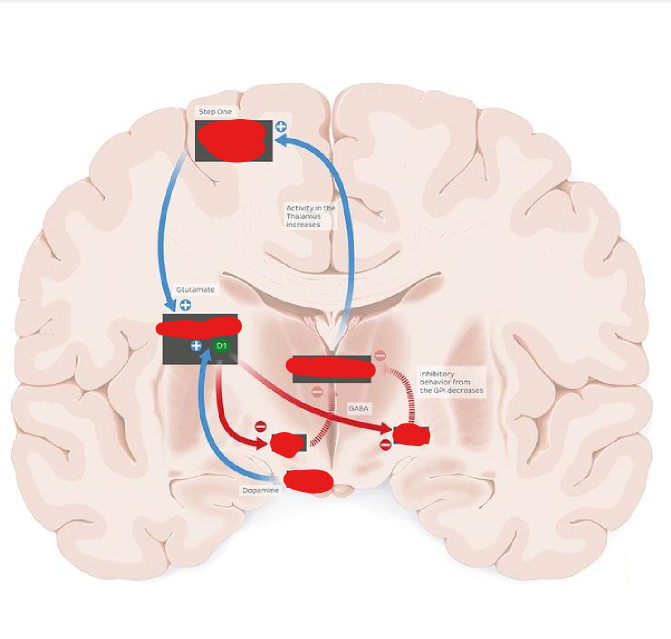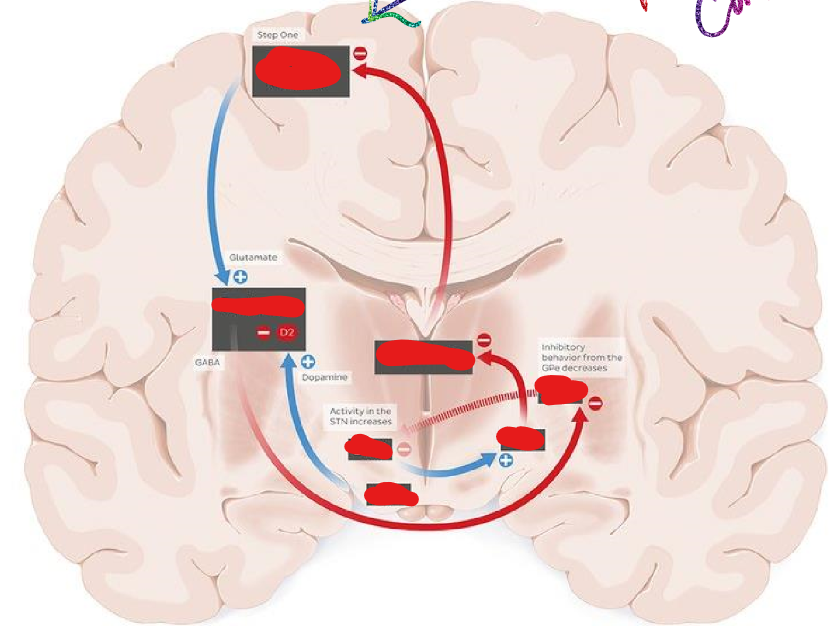NSCI 593A Exam 3
Pin adicionado em
119
1
0
Sem etiquetas
|
|
Criado por Marissa Alvarez
mais de 4 anos atrás
|
|
Fechar
|
|
Criado por Marissa Alvarez
mais de 4 anos atrás
|
|

Objectives
Basal ganglia
5 parts??
Basal ganglia
•Feedback loop between subcortical nuclei, thalamus, brainstem, and cerebral cortex
• Control of ____ motor movements (action selection)
• ____ of movement
• ___-___ of motor and premotor outputs
• Smoothly switch between behaviors
Caudate nucleus
•3 parts: ___, ___, __
• Head is continuous with the ____
• Tail terminates in the ___
Follows curvature of lateral ventricles
•Dopaminergic inputs from ____ ___
Putamen
•____ portion of the basal ganglia
•Continuous with ___ nucleus
• Connected by ___ ___ (fiber tract)
•Caudate + Putamen = ___ ____
Striatal afferents (inputs)
•____ fibers: excitatory inputs from PFC, premotor area, and primary motor cortex
•_____ fibers: inputs from intralaminar nuclei
•____ fibers: dopaminergic input from nigra
•_____ fibers: limbic system input
Striatal neurons
•___ ___ neurons:
• Principal neurons of the striatum (95% of striatum)
Express ___ receptors
Output neurons
• ____ (inhibitory)
*These cells fire in ___ of movement
Globus pallidus
•Internal (GPi) and external (GPe)
segments
• Separated by ___ ___ ____
•Putamen + globus pallidus (GPe and GPi)
= ___ nucleus
Globus pallidus
•Inputs from ____
•Sends outputs to the ___
•GABAergic
• Tonically active to ___
unwanted movement at rest
• Disinhibited by ___ ___
neurons
Important for regulation of
voluntary movement
Subthalamic nucleus
•Located ventral to the ____
•Inputs from ___
•Outputs to ___ ___
• Glutamatergic (___)
•Action selection
Substantia nigra
•Substantia nigra ("black substance") - dark appearance due to presence of ___
Pars compacta (SNc):
• Releases ___
• Fine motor control
•Axonal degeneration of SNc neurons = ___ disease
Pars reticulata (SNr):
• Releases ___
• ___ inhibition of motor outputs
Substantia nigra
•Inputs: ____
•Outputs:
• SNr sends ____ outputs to the thalamus and brainstem
• Primary output of basal ganglia for
___ movements
• SNc sends dopaminergic outputs to the striatum
• DI receptors: ____
• D2 receptors: ____
• Fine motor control and ____ processing
Direct pathway
Motor circuit for __-___ of muscle
activity
• Motor cortex (sends excitatory output to
___ in striatum)
• Striatum (sends inhibitory output to ___ & ___)
• Globus pallidus internal (becomes _____, so stops inhibiting thalamus)
• SNr (sends inhibitory output to ____)
• Thalamus (sends ___ output back to motor cortex)

Indirect pathway
• Motor circuit to prevent ____ muscle contractions from competing with voluntary movements
Motor cortex (sends excitatory outputs to ___)
Striatum (sends inhibitory outputs to __)
Globus pallidus external (becomes ____ so stop inhibiting subthalamic nucleus)
Subthalamic nucleus (sends excitatory outputs to ___)
___ of the inputs that GPi gets via the direct pathway
Thalamus (sends ___ ___ outputs to motor cortex)

Integration of the pathways
Cortical activity signals onset of movement
___ pathway inhibits GPi and
increases thalamic output
(facilitation of cortically initiated movement)
___ pathway excites GPi
and ___ thalamic output
(suppression of antagonistic
muscles/decreasing competing
movements).
**BOTH pathways are active at the __ time
Parkinson's disease
•Loss of ____ cells in SNc
•Reciprocal input between SNc and
striatum lost
•Subthalamic nucleus becomes ____ (b/c GPe inhibition of STN is completely removed)
•Increased excitatory outputs to __
•Greater inhibitory output from GPi
to ____
•Thalamic output to the cortex is
____
Parkinson's disease
•Loss of SNc dopaminergic neurons may be due to lesion, environmental toxin, or genetic causes
•Rigidity may be caused by decreased control of ___ neurons that control motor neurons. Impaired ability to prevent ___ muscle activity.
•____: reduced ability to initiate
voluntary movement
•____: involuntary movements (tremors, tics)
Deep brain stimulation
____ implantation of electrode into basal ganglia structures:
• subthalamic nucleus (STN)
• Internal segment of globus
pallidus (GPi)
•Levodopa-___ Parkinsons's
symptoms

 Ocultar acertos
Ocultar acertos